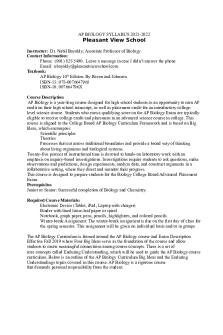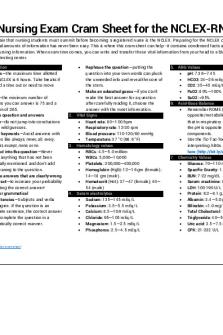AP Macro Cram Chart 2021 PDF

| Title | AP Macro Cram Chart 2021 |
|---|---|
| Author | oscar sume |
| Course | Macroeconomics |
| Institution | University of California Los Angeles |
| Pages | 1 |
| File Size | 121.8 KB |
| File Type | |
| Total Downloads | 12 |
| Total Views | 182 |
Summary
study sheet given by teachers...
Description
AP MACROECONOMICS CRAM CHART // @ thinkfiveable / / http://fiveable.me
Basic Economic Concepts Unit 1 ↓
● ●
● ● ● ● ● ● ●
Scarcity is created by unlimited wants and limited resources Economics is the study of scarcity and opportunity cost - the price of the next best thing when trade-offs are made, Economic systems dictate how scarce resources are a llocated We model opportunity cost on the p roduction possibilities curve (PPC) Straight = const. OC, bowed out = increasing OC The law of comparative advantage (CA) tells us how countries can increase productivity by specializing and trading CA: o utput: OTHER value goes over; input: IT goes over Absolute Advantage: country that can produce more The country with the lower OC for a good, will specialize in it Supply and Demand describe how markets are a relationship of buyers and sellers (surplus = Qd < Qs, shortage = Qd > Qs)
Financial Sector Unit 4 ↓ ● ● ● ● ● ● ● ● ● ● ● ● ● ● ● ●
Money has three functions: medium of exchange, store of value, and unit of account Liquidity i s how fast an asset can be turned into cash (most liquid is M1) Interest is the “price” of money, or the opportunity cost of holding money instead of investing Real IR = Nom IR - Inflation Rate (Fisher Equation) The money supply consists of M0, M1, and M2 money, M1 contains M0, and M2 contains M1 and M0 Bank Balance Sheets contain assets and liabilities Banks have a required reserve ratio set by the Fed Money Multiplier = 1/rr can be used to calculate changes in the money supply The Money Market describes the demand for money based on the n ominal interest rate The money supply is vertical because it is set by the Fed Tools of Monetary Policy: Buying/selling bonds (OMOs), required reserve ratio, the discount rate, and fed funds rate OMO’s are more effective because of the money multiplier Expansionary MP → MS↑ → Nom IR↓ → I↑ → AD↑ Contractionary MP → MS↓ → Nom IR↑ → I↓ → AD↓ The Loanable Funds Market brings together lenders and borrowers based on real interest rates
Tips & Tricks
FRQ
Economic Indicators and the Business Cycle Unit 2 ↓ ● The circular flow model which shows that money in an economy flows in an endless circle (from firms, individuals, the gov, etc.) ● Gross Domestic Product (GDP) is the dollar value of all finished goods and services produced in a countries border in one year ● Expenditure Approach: GDP = C + I + G + (X - N) ● Income Approach: GDP = W + i + R + P ● Value Added Approach: GDP = VOGS – IC ● Limitations of GDP: Does not determine quality of life ● GDP Per Capita (GDP/Pop) can tell us about quality of life ● Labor Force: all people who are able and willing to work ● Unemployment rate = unemployed in LF/total LF * 100 ● Types of Unemployment: C yclical, Frictional, Structural ● Natural Rate of Unemployment = no cyclical unemployment ● Inflation (increase in PL, helps borrowers, hurts lenders) is measured using CPI and GDP Deflator - unemployment hurts some and benefits others ● Economic indicators are summarized in the b usiness cycle
National Income and Price Determination Unit 3 ↓ ● Aggregate Demand is shifted by changes in C, I, G, Xn ● AD is downward sloping b/c of the wealth effect, interest rate effect, and exchange rate effect ● The multiplier effect explains how gov’t spending can increase GDP more than the amount spent ● MPC = C/ I, MPS = S/ I, MPC + MPS = 1 ● Spending Mult = 1/MPS, Tax Mult = MPC/MPS ● ΔGDP = S * Spending Mult or ΔGDP = - T * Tax Mult ● Short Run Aggregate Supply (SRAS) is shifted by changes in production costs ● Economic growth is shown by the L ong Run Aggregate Supply (LRAS), which is vertical at the NRU ● When the economy is not at long run equilibrium, it is either in an inflationary or recessionary gap ● The market adjusts in the long run (SRAS shifts) ● Fiscal Policy: changing spending/taxes to shift AD
Long-Run Consequences of Stabilization Policies Unit 5 ↓ ● Fiscal and monetary policies can be used in unison to r estore full employment ● Supply-side economics (known as trickle-down-economics) is the concept of cutting business taxes to help the economy and ● The short-run Phillips curve displays a trade-off between inflation and unemployment ● The long-run Phillips curve is vertical at the natural rate of unemployment ● The Phillips Curve can display inflationary and recessionary gaps ● Shifts in AD move along the SRPC and shifts in SRAS shift the SRPC in the opposite direction ● Changes in the NRU shift the LRPC ● The quantity theory of money (MV = PQ) states that increases in the money supply lead to inflation and vice versa assuming constant V and Q ● In MV = PQ, PQ = nominal GDP ● Government Budget Balance = tax rev. - gov’t spending ● Budget deficits get added on to the government debt ● Borrowing by the gov’t → dLF↑ → rIR↑ → business spending is crowded out → this is called the crowding out effect ● Economic Growth—measured in growth rate of rGDP/time ● Labor Productivity—defined by physical and human capital ● Economic growth is analogous to shifts in the PPC/LRAS
Open Economy-International Trade and Finance Unit 6 ↓ ●
●
●
●
● ●
● ● ●
A country’s balance of payments (BOP) is a summary of its international trade within 1 year, in terms of the domestic country’s current and capital accounts (one -, one +, a dd up to 0) Current account: tracks exports/imports, includes net exports, invest income (from factors of production), and net transfers Capital account: tracks ownership of assets/investment abroad and domestically, includes stocks, bonds, and capital Net capital: outflow = negative, country invests more than other countries in it, inflow = positive, country has more investment in it that it invests Debit: money going out, Credit : money coming in FOREX Market shows floating exchange rates (the value of two currencies relative to each other) and is dependent on tastes, price levels, income, and interest rates Appreciation: increase in value, Depreciation: decrease in value (if one appreciates, other MUST depreciate) Supply of FOREX = domestic country, Demand of FOREX = foreign country ↑IR = ↑demand (because of higher rate of returns)
● When in doubt, graph it out! Keep a sheet of paper near you to take notes, draw graphs, and do basic calculations ● Be sure to practice the more mathy aspects of AP Macro (comparative advantage, terms of trade, calculating macro measures (GDP, unemployment, inflation), bank balance sheets, multiplier effect, MV=PQ ● Assume your answers are correct—if your answer in part (b) is consistent with your answer in part (a), you’ll get the point for (b) regardless of (a), given (b) was correct and consistent. ● Don’t go down the cause and effect rabbit hole—ex: Supply decreases, meaning price increases, meaning demand does this...
...
Similar Free PDFs

AP Macro Cram Chart 2021
- 1 Pages

AP Psych Cram Chart 2021
- 1 Pages

Ap government cram sheet
- 30 Pages

AP macro FRQs 2019
- 12 Pages

THE BEST AP Psychology CRAM Sheet
- 12 Pages

Pdf. AP Bio~ Exam Cram Packet
- 13 Pages

Writing 2021/2020 Macro
- 3 Pages

AP Biology Syllabus 2021
- 5 Pages

AP Macro EXAM Review Sheet Answers
- 22 Pages

Nurseslabs nclex cram sheet
- 9 Pages

Nurseslabs-cram-sheet
- 9 Pages
Popular Institutions
- Tinajero National High School - Annex
- Politeknik Caltex Riau
- Yokohama City University
- SGT University
- University of Al-Qadisiyah
- Divine Word College of Vigan
- Techniek College Rotterdam
- Universidade de Santiago
- Universiti Teknologi MARA Cawangan Johor Kampus Pasir Gudang
- Poltekkes Kemenkes Yogyakarta
- Baguio City National High School
- Colegio san marcos
- preparatoria uno
- Centro de Bachillerato Tecnológico Industrial y de Servicios No. 107
- Dalian Maritime University
- Quang Trung Secondary School
- Colegio Tecnológico en Informática
- Corporación Regional de Educación Superior
- Grupo CEDVA
- Dar Al Uloom University
- Centro de Estudios Preuniversitarios de la Universidad Nacional de Ingeniería
- 上智大学
- Aakash International School, Nuna Majara
- San Felipe Neri Catholic School
- Kang Chiao International School - New Taipei City
- Misamis Occidental National High School
- Institución Educativa Escuela Normal Juan Ladrilleros
- Kolehiyo ng Pantukan
- Batanes State College
- Instituto Continental
- Sekolah Menengah Kejuruan Kesehatan Kaltara (Tarakan)
- Colegio de La Inmaculada Concepcion - Cebu




